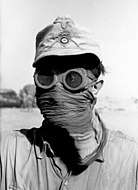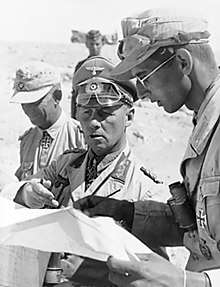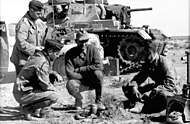Afrika Korps
The Afrika Korps or German Africa Corps (German: Deutsches Afrikakorps, DAK ![]()
| Deutsches Afrikakorps | |
|---|---|
 Seal of the Deutsches Afrikakorps | |
| Active | 21 February 1941 – 13 May 1943 |
| Country | |
| Branch | Army |
| Type | Expeditionary force |
| Size | Corps |
| Garrison/HQ | Tripoli, Italian Libya |
| Colors | Yellow, brown |
| Engagements | World War II
|
| Commanders | |
| Notable commanders | Erwin Rommel Ludwig Crüwell Wilhelm Ritter von Thoma Walther Nehring |
Organization
The Afrika Korps formed on 11 January 1941 and one of Hitler's favourite generals, Erwin Rommel, was designated as commander on 11 February. Originally Hans von Funck was to have commanded it, but Hitler loathed von Funck, as he had been a personal staff officer of Werner von Fritsch until von Fritsch was dismissed in 1938.[1]
The German Armed Forces High Command (Oberkommando der Wehrmacht, OKW) had decided to send a "blocking force" to Libya to support the Italian army. The Italian army group had been routed by the British Commonwealth Western Desert Force in Operation Compass (9 December 1940 – 9 February 1941). The German blocking force, commanded by Rommel, at first consisted of a force based only on Panzer Regiment 5, which was put together from the second regiment of the 3rd Panzer Division. These elements were organized into the 5th Light Division when they arrived in Africa from 10 February – 12 March 1941. In late April and into May, the 5th Light Division was joined by elements of 15th Panzer Division, transferred from Italy. At this time, the Afrika Korps consisted of the two divisions, and was subordinated to the Italian chain of command in Africa.[2]
On 15 August 1941, the German 5th Light Division was redesignated 21st Panzer Division, the higher formation of which was still the Afrika Korps. During the summer of 1941, the OKW increased the presence in Africa and created a new headquarters called Panzer Group Africa. On 15 August, the Panzer Group was activated with Rommel in command, and command of the Afrika Korps was turned over to Ludwig Crüwell. The Panzer Group comprised the Afrika Korps, with some additional German units now in North Africa, plus two corps of Italian units. The Panzer Group was, in turn, redesignated as Panzer Army Africa on 30 January 1942.[3]
After the German defeat in the Second Battle of El Alamein and the Allied landings in Morocco and Algeria (Operation Torch), the OKW once more upgraded the presence in Africa by adding first the XC Army Corps, under Nehring, in Tunisia on 19 November 1942, then an additional 5th Panzer Army on 8 December, under the command of Colonel-General Hans-Jürgen von Arnim.
On 23 February 1943, the original Panzer Army Africa, which had since been re-styled as the German-Italian Panzer Army, was now redesignated as the Italian 1st Army and put under the command of Italian general Giovanni Messe. Rommel, meanwhile, was placed in command of a new Army Group Africa, created to control both the Italian 1st Army and the 5th Panzer Army. The remnants of the Afrika Korps and surviving units of the 1st Italian Army retreated into Tunisia. Command of the Army Group was turned over to Arnim in March. On 13 May, the Afrika Korps surrendered, along with all other remaining Axis forces in North Africa.
Most Afrika Korps POWs were transported to the United States and held in Camp Shelby in Mississippi, Camp Hearne in Texas and other POW camps until the end of the war.[4]
Composition and terminology
When Rommel was promoted to the newly formed Panzerarmee Afrika, his command included a number of Italian units, including four infantry divisions. Two Italian armoured divisions, Ariete and Trieste, initially remained under Italian control as the Italian XX Motorized Corps under the command of General Gastone Gambara.[5]
The Afrika Korps was restructured and renamed in August 1941. "Afrikakorps" was the official name of the force for less than six months but the officers and men used it for the duration. The Afrika Korps was the major German component of Panzerarmee Afrika, which was later renamed the Deutsch-Italienische Panzerarmee and finally renamed Heeresgruppe Afrika (Army Group Africa) during the 27 months of the Desert campaign.[6][7]
Persecution of Jews
Robert Satloff writes in his book Among the Righteous: Lost Stories from the Holocaust's Long Reach into Arab Lands that as the German and Italian forces retreated across Libya towards Tunisia, the Jewish population became victim upon which they released their anger and frustration. According to Satloff Afrika Korps soldiers plundered Jewish property all along the Libyan coast. This violence and persecution only came to an end with the arrival of General Montgomery in Tripoli on January 23 1943.[8] German historian Clemens Vollnhals writes that use of Jews by Afrika Korps as forced labour is barely known, but it did happen alongside persecution of Jewish population (although on smaller scale than in Europe) and some of the labourers have died[9]
Gallery
_tropical_uniforms_officers_and_enlisted_men_-_no_known_copyright.jpg) Wehrmacht tropical uniforms: officers and enlisted men
Wehrmacht tropical uniforms: officers and enlisted men
Illustration: "Handbook On German Military Forces" (TM-E 30-451, United States War Department, 1943) Three German Afrika Korps officers confer atop a tank. The Hauptmann on the right is wearing a captured British uniform blouse.
Three German Afrika Korps officers confer atop a tank. The Hauptmann on the right is wearing a captured British uniform blouse. A German soldier wearing goggles and face covering to protect against sandstorms.
A German soldier wearing goggles and face covering to protect against sandstorms. Erwin Rommel in North Africa
Erwin Rommel in North Africa Hans-Jürgen von Arnim, the last commander of the Afrika Korps (then renamed to Army Group Africa) in Tunisia
Hans-Jürgen von Arnim, the last commander of the Afrika Korps (then renamed to Army Group Africa) in Tunisia A Panzerjäger unit pulling a 3.7 cm Pak 36 anti-tank cannon.
A Panzerjäger unit pulling a 3.7 cm Pak 36 anti-tank cannon. A Panzer II of the Afrika Korps with a faded insignia.
A Panzer II of the Afrika Korps with a faded insignia. The crew of a Panzer III Ausf.J heating up a meal.
The crew of a Panzer III Ausf.J heating up a meal..jpg) A Tiger I deployed to supplement the Afrika Korps operating in Tunisia
A Tiger I deployed to supplement the Afrika Korps operating in Tunisia
Reforming of units
Certain divisions were reformed in Europe after the cessation of fighting in Tunisia:
- 15th Panzer Division (as 15th Panzergrenadier Division in Sicily, Italy and Western Front)
- 21st Panzer Division (in France)
- Hermann Göring Panzer Division (in Sicily and Italy)
- 90th Light Division (as 90th Panzergrenadier Division in Italy)
See also
- Fliegerführer Afrika
- Ramcke Parachute Brigade
- Western Desert Campaign
- László Almásy
- Operation Salaam
References
- Beevor, Antony (2009). D-Day: The Battle for Normandy. London: Viking. p. 405. ISBN 978-0-670-88703-3.
- Pier Paolo Battistelli (20 January 2013). Rommel's Afrika Korps: Tobruk to El Alamein. Bloomsbury Publishing. pp. 12–. ISBN 978-1-4728-0081-7.
- Bruce Gudmundsson (30 August 2016). Inside the Afrika Korps: The Crusader Battles, 1941-1942. Frontline Books. pp. 19–. ISBN 978-1-84832-996-6.
- Beasley 2010, p. 262.
- Lewin 1968, p. 54.
- Toppe 1952, p. 14.
- Ian Baxter (30 January 2019). The Armour of Rommel's Afrika Korps - Introduction. Pen and Sword. ISBN 978-1-5267-1380-3.
- Robert Satloff Among the Righteous: Lost Stories from the Holocaust's Long Reach into Arab Lands 2006 page 44
- Kaum bekannt ist, dass auch das deutsche Afrikakorps Juden zur Zwangsarbeit heranziehen ließ. Die Judenverfolgung gestaltete sich in Nordafrika nicht so mörderisch wie in Europa, doch starben einige der Zwangsarbeiter doch starben einige der Zwangsarbeiter Wehrmacht, Verbrechen, Widerstand: vier Beiträge zum nationalsozialistischen Weltanschauungskrieg, page 55 Clemens Vollnhals Hannah-Arendt-Institut für Totalitarismusforschung e.V. an der Technischen Universität Dresden, 2003
Sources
- Cooper, Matthew (1990). The German Army 1933–1945. Scarborough House. Chelsea, MI, USA. ISBN 0-8128-8519-8.
- Lewin, Ronald (1998) [1968]. Rommel As Military Commander. New York: B&N Books. ISBN 978-0-7607-0861-3.
- Von Luck, Hans (1989). Panzer Commander: The Memoirs of Colonel Hans von Luck. New York: Dell (Random House). ISBN 0-440-20802-5.
- von Mellenthin, Major General F. W. (1971) [1956]. Panzer Battles Panzer (First ed.). New York: Ballantine Books. ISBN 0-345-24440-0.
- Rommel, Erwin (1982) [1953]. Liddell Hart, B. H. (ed.). The Rommel Papers. New York: Da Capo Press. ISBN 978-0-306-80157-0.
- Toppe, Generalmajor Alfred (1990) [1952]. German Experiences in Desert Warfare During World War II (PDF). The Black Vault (Report). II. Washington: U.S. Marine Corps: Historical Division, European Command. FMFRP 12-96-II. Retrieved 15 October 2013.
Further reading
- Chamberlain, Peter (1971). Afrika Korps: German military operations in the Western Desert, 1941–42. Almark Publishing. ISBN 0-85524-018-0. OCLC 165305.
- Macksey, Kenneth (1968). Afrika Korps. Ballantine Books. ISBN 0-35602-544-6.
- Mitcham, Samuel W. (2007). Rommel's Desert War: the Life and Death of the Afrika Korps. Stackpole Books. ISBN 0-81173-413-7.